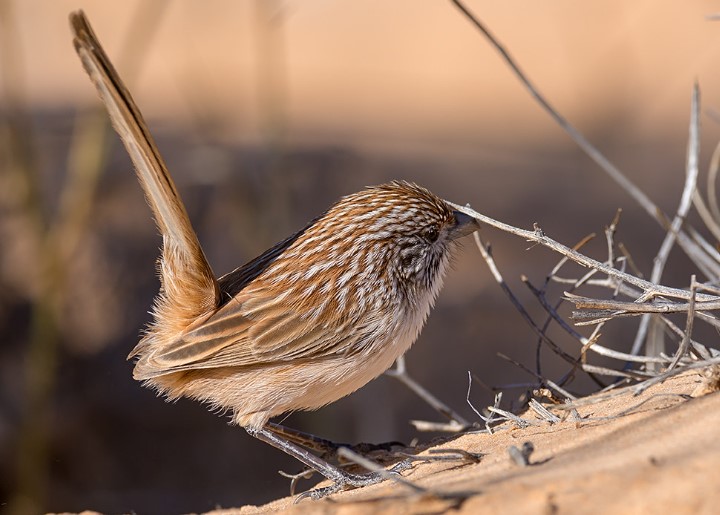Family: Dusky grasswren (Amytornis purnelli) belongs to the family Maluridae.
Habitat: Rock-strewn hills and gorges clad with spinifex are the habitat of the dusky grasswren in central Australia. More curious and communal than many grasswrens, they travel about their local foraging range in groups of up to a dozen or more—both in and out of breeding, hopping, calling, and running over the rocks and among the spinifex like rats, heads down but tails cocked high and quivering.
Diet: Seeds and a range of insects—ants, beetles, grasshoppers, bugs, and flies—are picked from nooks. Led by males, the birds feed quietly, but whenever they drift apart, they begin to chirp and sing in brief bursts.
Behavior: It enables them to regroup. If disturbed, they scatter instantly, dashing and diving in all directions into the cover of crevices and passages under boulders. Breeding groups are smaller and ·often comprise only the dominant territorial pair. Females incubate and brood unaided, and males sing much more than at other times, presumably to advertise territory. They sing mostly from the top of vantage rocks, heads, and tails up, swiveling about to beam out their brief songs in different directions.
Both sexes feed the young, approaching the nest quietly and furtively along the ground from different directions and departing quickly with a long hop to the ground. If young are threatened, all members of the group respond with a ‘rodent-run’ distraction display, scrambling about, squeaking, with heads hunched, tails lowered, and wings dragging on the ground. Two broods may be raised in a season.
Identification: The male head is dusky, grading to deep rufous-brown over the back and greyer wings, finely streaked white, edged dusky; brow faint rufous, no malar stripe. Tail slender, dusky brown, edged rufous. Throat and breast soft, dull rufous, streaked cream, and belly brown-rufous (central Australia) or stiff-feathered, straw-toned, with pale streaking edged black and belly grey (Selwyn Range, Queensland). The eyes are brown. The bill and feet are dusky. The female bird patch of rufous at the sides of the breast (central Australia}, or belly-flecked dusky with a sash of rufous down flanks (Selwyn Range, Queensland) The immature bird (as an adult) is a little duller.
Vocalizations: Dusky grasswren call is high; trilled “sreeee”, in contact; sharp chirps tt-tt-tt in alarm. The song is high, staccato, metallic trills, up-slurred, then down-slurred.
Nesting and breeding occur mainly in August–October and February–April. Nest a full- or semidome of loosely interwoven grass stems, lined with shredded fiber, in clumps of spinifex to 500 mm high.
Eggs: The bird lays 2 to 3 eggs; glossy white-pink, closely spotted and blotched with red-browns; swollen oval, about 21 x 15 mm.
Flight: Dusky grasswren flight is rare; the birds rely on their legs to carry them to safety.
Distribution: Dusky grasswren is found in rocky, spinifex-clad hills throughout central Australia, from Birksgate Range, South Australia, to Ashburton Range, NT; also, Selwyn Range, Qld.
Races: There are two very distinct races.
Alternative Name: It is also known as a thin-billed grasswren and a dark grasswren.
Size: Dusky grasswren measures about 150–180 mm in length.
Read More: Black Grasswren (Amytornis housei)







